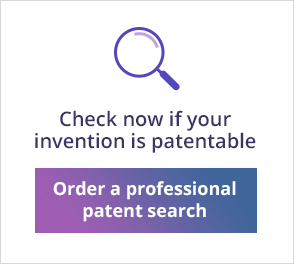
If you ask yourself the following question: I have an innovative idea, but what should I do right now? Then this article is for you. As a patent search company, we get that question a lot. Regardless if you are a private inventor trying to cash in on it or an entrepreneur planning to build a business, getting a patent is essential.
An enforced patent in several big markets will provide you with:
- An actual asset that can be sold or licensed in exchange for cash or royalties
- Protect you from theft and copying by others.
- Dramatically increases your product/ company’s value.
So let’s talk about how you patent an innovative idea.
How to patent an innovative idea in three main stages
First stage: Answering basic questions via self and professional patent search
Do your homework! It is important to remember the patent laws in most countries (US, UK, Europe, China etc) stipulate two main conditions that an invention must meet in order to be patentable – A complete universal novelty and non obviousness (also referred to as an inventive step).
Before going drafting and filing a patent application you must answer basic questions via self and professional search:
- I have an innovative idea, but in what way is it different from existing tech? (What are the problems the invention solves and how, key features, advantages over existing solutions etc).
- Does my invention already exist?
- Is my business idea good?
- Who and where are my customers and markets?
- What is my end business goal (filing and getting a patent and then selling or licensing it? or start a company)
A patentability search is necessary not only to answer the question: “Does my invention exist”, but also to find publications that are close to the invention in such a way that might endanger the chance of patentability (i.e patents or other publications that show your invention might not have an inventive step).
Since patents are written in a very legally/technically professional language, it is important to conduct a patentability search which is done by a patent searcher who is skilled in using paid databases and is trained both in the relevant technological fields and the patent legal field.
Conducting a patentability search will save you money
A patentability search costs only a tiny fraction from the total process of getting a patent and maintaining it in several major countries (Patents are county based – you must get a patent in each country you need protection). Getting a granted patent in a single country and maintaining it for 20 years can cost between several thousand to several tens of thousands of pounds. In our global market you need to protect yourself in several major states, therefore a multinational patent protection will cost a few tens of thousand pounds.
If you are an entrepreneur building a startup or a manager of a company planning to develop a new product (and not just getting a patent for selling it), a patentability search can help you to decide whether you need further patent searches:
- Freedom to operate search – in order to find any enforced patents on the whole or part of your invention that might prohibit you from manufacturing and marketing the product.
- State of the art search – Giving you a commercial and technological survey of the invention field and competitions.
- Patent Landscape Report (PLR) – Mapping of your invention’s field, from technological and business IP aspects (major competitors, technological trends, common solutions, etc.
Second stage: Analyze the patent search report with an IP consultant/patent agent/attorney and decide how to continue.
After getting all the information it is highly recommended to reach an IP specialist such as a patent
agent/attorney, go over the finding and decide if and how to continue. The analysis can end in several major outcomes:
- There are no publications that stop you from getting a patent – continue to the next stage.
- There are no identical publications denying you from getting a patent, however there are enforced patents on features of your invention – make sure you conduct a freedom to operate search (see above) now or in the future.
- Identical or very similar publications were found (patents, products, articles etc) which show you don’t have an inventive step (it’s not an innovative idea).

If the third option occurs you must go back to the drawing board and decide whether to:
- Abandon the attempt to patent the idea, conduct a freedom to operate search and if there are no limiting patents develop and market your idea. Remember – most products are not patent protected and most patents don’t become products!
- Go back to the drawing board – Try to improve or fine tune your idea in a way creating an edge over existing published solutions i.e giving it an inventive step. Then conduct a second patentability search focused on the change and make sure it is new, thus making your invention patentable.
Third stage: Choose the Most Suitable IP path, draft and file
Now you should choose the most suitable patent filing mechanism such as
- Filing a single national application (giving you 12 months to file in other countries)
- Filing in multiple countries simultaneously.
- Filing a PCT application (giving you 30 months until you must file in the relevant countries)
- Filing an US provisional (granting you 12 months to start a regular filing process of a full patent)
The decision should include not only legal parameters but also commercial and economical ones (what are the end goals, where are the relevant markets, what are your financial resources etc.)
In accordance with the filing mechanism you chose, your patent attorney/agent will draft and file a patent application. You must pay the relevant fees and the process of examination will start.
What happens next?
The search process takes several months at the patent office where you file. The majority of patent applications get some sort of first rejection and the applicant must argue and try to convince the patent examiner why it’s an innovative idea.
Then the examination process can take years and be very costly, hence the importance of a high quality patentability search. Such a search will give a map of relevant prior publications, allowing you to be fully prepared for the examination process.
At the end of the process you will either get a final rejection or a final grant (in many countries, such as the US for example, the rate of granted application is around 50%).
If the patent application is approved and a patent is granted, you must now pay annuity fees every year for the patents 20 years of life.

